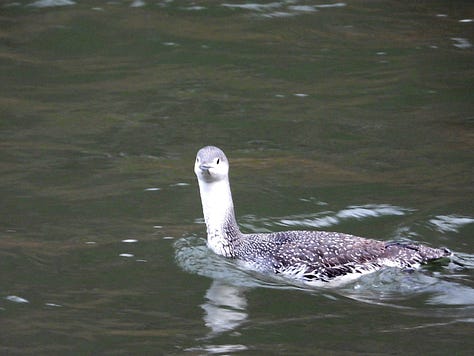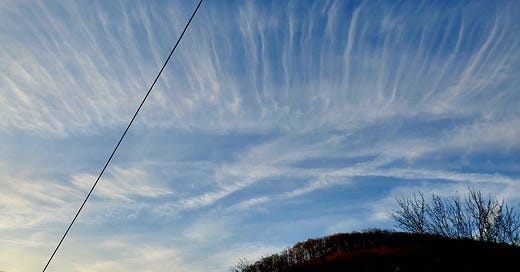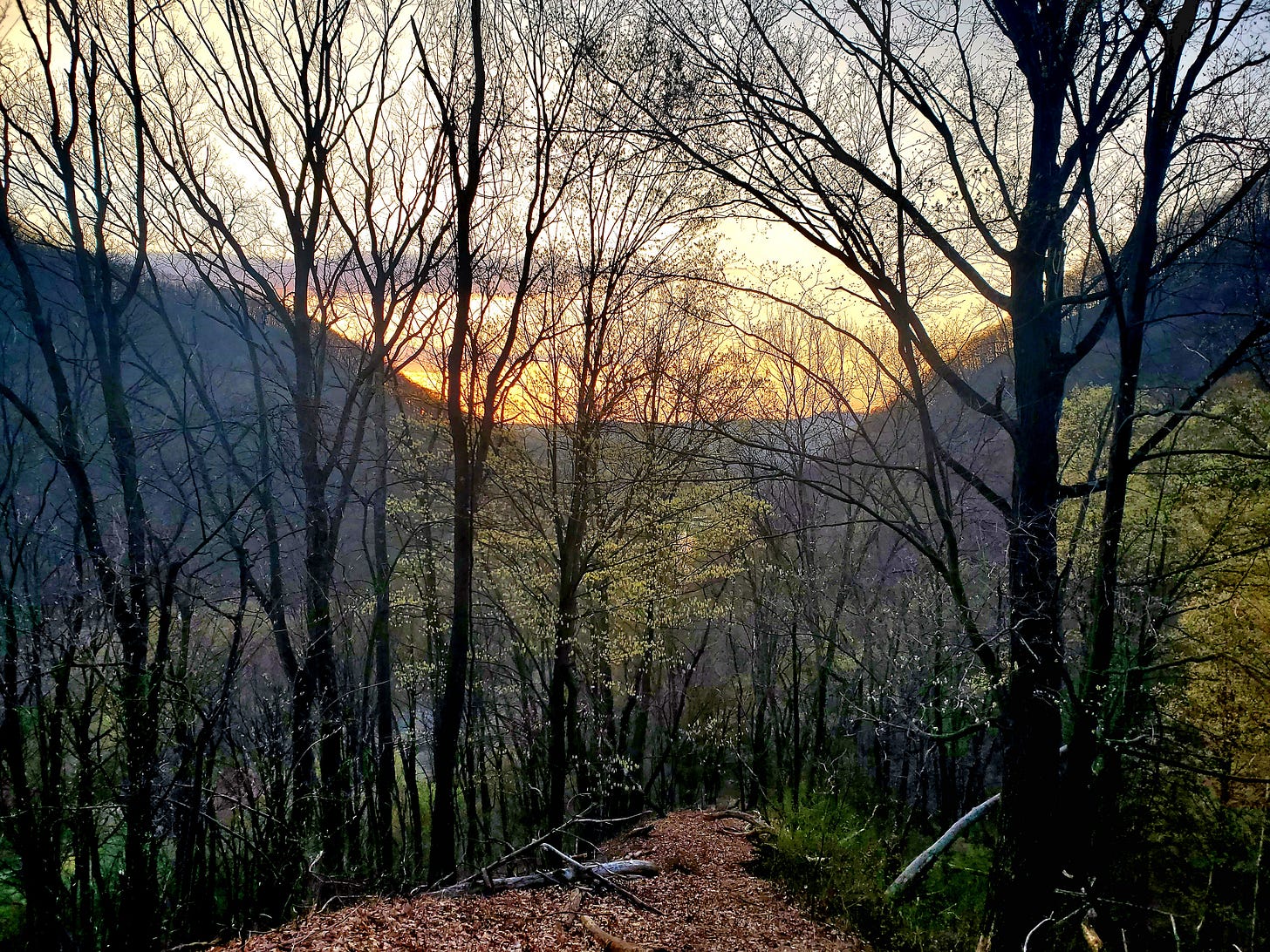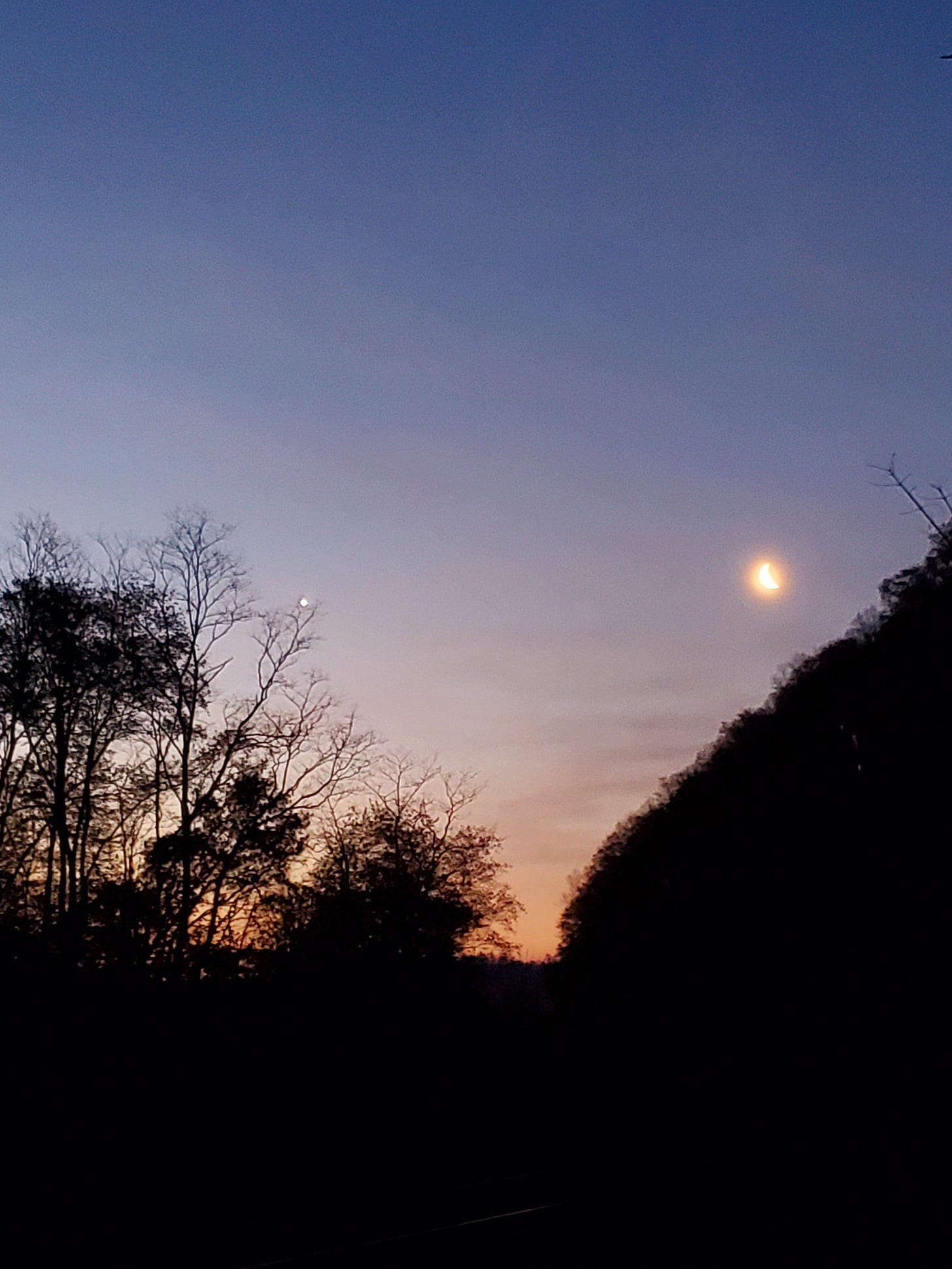Look to the skies!
Flockwatching
The last time I posted, I fully expected the 350+ non-local American Robins that had built up by the 14th to dissipate rapidly with the south winds, but they took their good old time. On the evening of the 22nd, some 340 returned west to roost, including a single cloud of over 100. The next morning, less than 60 commuted east, and by the morning of the 25th, just a single group of around a dozen commuted; all the rest I tallied were locals.
I would guess the flock either broke up here, or moved northward or in some other direction. I’ve got no clue where the lingerers here commuted to every day. I would guess there was some specific attractive resource out in the valleys, as I didn’t notice elevated numbers diving into or out of the mountains in-between.
I had also assumed, when I last wrote in this space, that Common Grackles were done with their early spring flocking as well, and had settled down to fight over mates and territories. And indeed, April grackle numbers did dwindle to a few dozen:
158 (dusk, 1st)
150 (dawn, 5th)
27 (dawn, 11th).
But then, on the 14th at dawn, with a change in the weather, several large grackle flocks swept low over town, heading northeast up the valley—490 in all, as winds blew from both south and north, in mildly stormy conditions. The same dynamic happened the next morning, but just 223 repeated the performance, along with a few smaller Icterid hangers-on. These seemed likely to be components of a late, northward-moving migratory flock, so I figured that numbers would rapidly decrease until I was only seeing at most a couple dozen, as happened the last few years — the returns to roost of the local population.
But full return-to-roost counts (c. 6:30-8:20 PM) took all the way until the 23rd to drop below 100 (AM counts are harder to do, as they leave early and often fly low through the dark Gap, eastward, making them difficult to tally from the balcony).
Entering the last week of the month, the grackle migration seems to finally be over. Fewer and fewer grackles in groups larger than two are flying at any time of day. While the Grackleville settlement at the confluence, bursting with them a couple years, seems to be no more, overall numbers are still noticeably up from last year.
The Left-Behinds



The Red-throated Loon was still there on that unsettled and grackly morning of the 14th, but it was gone by the afternoon. I hope it made a clean getaway. I pretty much thought by then that the unusual waterfowl were played out, but plenty more surprises were in store.
The morning of Tuesday, the 15th, the weather appeared to be slowly shifting toward a south wind, after another unsettled night. Just after 7:30 AM, the year’s first Great Egret floated through the Gap and overhead, taking its good old time, as the few I see here tend to do. A few minutes later, a raspy, fast vocalization from the local nesting Common Ravens caught my attention—I had never heard this precise call before. A few seconds later, one of the immature Bald Eagles that hangs around our parts burst from the sycamores with a raven in hot pursuit. The raven dove repeatedly at the larger bird and chased it away downriver, with the eagle making only feeble attempts to retaliate.
I suppose the raven was getting a taste of its own medicine. In the week prior, I watched both American Crows and grackles chase and attack ravens through the Gap and up on the mountain.
Scoter!
Later that same morning, I worked out on the balcony, with one eye peeled for Broad-winged Hawks and Ospreys surfing the updrafts against giant, puffy cumulus and dark blue skies; judging by the speeds of the birds, winds aloft were quite rapid. A Red-shouldered Hawk, several broad-wings, and other raptors were about, the locals mixing with the through traffic, often but very high up and completely invisible to the naked eye. A pair of Chimney Swifts could be seen, the first of the season, as well as the first Purple Martins and other swallows on the move.
A large duck zoomed by, hundreds of feet above the ridge but nearly perpendicular to it, straight north: White-winged Scoter! This was greatly unexpected, but maybe only because I haven’t spent enough mid-April time staring for hours into the clouds. The only other scoter we’ve ever recorded here was this same species, back in April 1979, floating on the river during the Day of the Ducks.
Goose hawk
As the days progressed, the skies became even more unusual. On the 16th, I got a close look at an accipiter that definitely wasn’t a Cooper’s or a Sharp-shinned — the first American Goshawk we’ve recorded here in decades. It, too, seemed delayed, popping up at dawn from the thick of the ridge and then heading northward to parts unknown. I could make a positive ID only because I happened to be right underneath it, down at the bridge. I almost thought it stayed around for a few days when I saw a suspect shape along the ridge a few times, but at a half-mile away, it was too hard to tell. What is certain is that the bird disappeared, hopefully to find a nest and even breed somewhere in the Northern Tier or beyond, where the species still persists, albeit in extremely tiny numbers.
Spiraling sawbill
Instead of a warming trend, we were afflicted by another round of cold and northerly breezes. The 17th dawned a frigid 29 degrees and, as you would guess, crystal clear. A laggard V of 15 Canada Geese headed north, despite the wind, a half-minute ahead of a quartet of Common Loons that formed the vague outline of a diamond. A bird I’ve already picked up on the antenna, American Black Duck, was also up and out by 7:05, as well as a few more loons.
By mid-morning, a Cliff Swallow had also made an appearance—last of the common swallows to return (Bank is the odd one out - a tough May species here)—and winds picked up, with promising clouds. I didn’t figure there were many more day-migrating waterfowl left to see, but I spent several hours staring into space nonetheless.
The day’s reward was another species I should probably spend more time in April trying to glimpse. It was a Red-breasted Merganser—only the second record for the hotspot, following last year’s small flock. The species isn’t at all extraordinary, given the time of year and the sheer numbers of northbound waterfowl bottled up in local lakes and only now able to depart.
What was extraordinary, at least to me, was the series of six broad loops it undertook to gain altitude. I’ve never seen a merganser, or any duck for that matter, execute maneuvers I associate with raptors and Rock Pigeons. It emerged from somewhere on the other side of Brush Mountain—I would have to guess one of the old quarry ponds. Once it attained the proper altitude, it shot north and out of sight.
Nocturnal flyovers
Slowly but surely, prevailing night-time winds shifted to the south and daytime temperatures warmed to the 70s and even the 80s. As luck would have it, I messed up part of the antenna assemblage during the two biggest NFC nights of the year thus far, when several million birds went over the county. This, on top of data loss due to the computer not handling the frigid temperatures well, and I started to get antsy about missing the bittern migration.
I needn’t have worried. By the time I was able to get a couple good nights of recording, around the 20th, multiple American Bitterns were going over, and on the 22nd, an early Least Bittern, first one of the year detected in PA, also flew by, seconds ahead of a Virginia Rail. Later that night, the first Green Heron showed up.
A surprise repeat performance of a Common Gallinule, after this one from the 13th, also occurred on the 20th, as well as three more Grasshopper Sparrows, a species that has been surprisingly early this year. (A nice Vesper Sparrow flight call on the night of the 24th was the first record, and possibly the last, of the year, for this declining species.)
The winds and sky weren’t done with me yet, even though the weeks ahead would need to be focused mostly on the foliage. Dawn on the 22nd was windy and cloudy, and I expected some odd appearances. I was not disappointed: a Palm Warbler came within earshot of the balcony, and a Spotted Sandpiper went by overhead, both FOYs. The strangest sight, to me, was a lone Caspian Tern, not far over my head, flying resolutely eastward, as if it had spent the night in the reservoir, dodging off-and-on storms. I picked up Caspians a couple Aprils ago, via NFC, the first records for the hotspot. Otherwise, I’ve never seen them closer than the big reservoirs at the state parks.
When I went to get the NFCs, I found a froggy noise from the wee hours that I spent half an hour before bed comparing to Short-eared Owls and various herons, but nothing matched. I knew I had heard it before. So the next morning, I played it to Merlin—instant hit. Caspian Tern, perhaps the self-same individual I had spotted a few hours later.
The moral of the story is that I need to freak my neighbors out even more by spending even more April hours staring at the sky. I’ve never even seen them glance up.
Back on Earth
The early warblers are, I admit, a bit of an obsession. On the 18th, it seemed as if conditions were just about right for the first mini-fallout. I had been combing the Gap for Yellow-throated Warblers, but to no avail—it seems as if this one slipped through the net this year. The next true challenge is the suite of rare May species—Mourning, Kentucky, etc. In the interim, I like to see what regular species show up by the end of the third week, and then, with Plummer’s Hollow finally near the top of the year list for PA hotspots, how many of the rest of the crowd returns before the end of the month.
The preferred dawn route for the first fallout was straight up the Sapsucker knife-edge and then left along faint trails grown over with tick-infested barberry. A Yellow-bellied Sapsucker was still around, but numbers of Brown Creepers and Golden-crowned Kinglets were noticeably down. Ruby-crowned Kinglets were near their peak, but the tall tulip-trees in Hanging, Big Tree, and Fisher hollows were still devoid of new warblers. But then, along Greenbriar Trail, with both kinglet species flocking in the vine-covered trees, that distinctive sound—weesy-weesy-weesy—Black-and-White vanguard of the coming horde. He returned directly to a preferred breeding territory, not unusual for the resident warblers.
More evidence of a late season, over 100 Dark-eyed Juncos were still around, but they would soon be gone, following the vanished Fox Sparrow, which, though I didn’t make an all-out effort, still had its state-high total here a few weeks prior. Ditto Eastern Towhees, topping the rest of PA with 78 on this hike.
Some commotion from Blue Jays and crows up toward the top of the ridge revealed a Barred Owl flying swiftly away through the tangles, followed immediately by a Cooper’s Hawk with something in its talons. Alarm calls of other birds were also going off, but not enough to deter the kinglets. I supposed it was one of the couple nesting at Eric’s.
A bit later, the season’s first Cedar Waxwing flock crossed the narrow neck of the field. That night, a text from Dave announced the year’s first Eastern Whip-poor-will.
Warblers in; creepers out
The next day, a Saturday, I did the same hike, but with much better results. This time, a bona fide warbler flock was feeding in Hanging Hollow, right off the ridge crest: the earliest Blackburnian recorded in the state, along with a Black-throated Green, a Black-and-white, and even a Northern Parula, one we don’t usually get this early up on top. Farther along the route, the Black-and-white was in the same spot, and Black-throated Greens were spaced out within their prime breeding territories—six in all over the course of a mile. It amazes me how male breeding warblers consistently arrive directly to breeding territories—I have to wonder if it isn’t some of the self-same individuals year after year, or their offspring.
Another highlight was a gorgeously singing Purple Finch mixed in with some warblers, and coming in close to check out what was pishing. Mom later told me she’s had small groups at the feeder—certainly an improvement over the dismal numbers of the last couple of years.
A third back-to-back hike on the high route on Easter morning was less productive, with much less time to spare. One pleasant surprise was the earliest-ever Northern Waterthrush, another tough-to-get warbler, with a couple of Louisianas along the river.
The deluge
On the weekend, I predicted that most of the typical April returnees would be back by the end of the coming week, thanks to the promised spate of warm and dry days. However, even I was surprised by how full the woods had become when next I ventured out, on Thursday. I carved time out for a hike after Eric’s PUC microphone picked up an Ovenbird the day before—a clear sign that the next wave had landed.
By 5:30 AM, after the customary Thursday gym workout, I left Tyrone and its robin chorus behind for the silence of the tracks, guided by twin crescents in the east. I was a bit behind schedule: I needed to already be up on Dogwood Knoll by this time to catch the first sounds. Striding up the first stretch of Hollow in the clammy 40s, I heard the first Wood Thrush (13 more sang over the next hour). Ovenbirds started up soon after, then American Redstarts, and then a Scarlet Tanager. With sunlight nipping the ridge, the warblers fired up, back on breeding territories: Worm-eating, Cerulean, Hooded. Minutes later, the first Red-eyed Vireo, with a few more later on. I plodded on, intent on doing the full loop to the end of Far Field and back. In First Field, an early Indigo Bunting, several very loud Common Yellowthroats, and a curious Nashville Warbler. The Nashville was in the exact patch where I consistently record the highest numbers during fallouts.
At the Far Field, Red-headed Woodpeckers were as raucous as always, getting set to breed, I would imagine. I saw where flat stones had been piled at the base of a big oak, where I believe Mom goes quite regularly to watch the show.
On the way back, I paused at the garage to work on a feedback issue with the antenna. After that, it briefly seemed a wise idea to not push it and instead just head back down the road and go to work. But, I thought, what if more warblers had woken up since I came through two hours before?
Back on Greenbriar, Merlin proclaimed a Warbling Vireo, but I wasn’t having it. Wrong habitat. But then, at a preferred spot (the common refrain here), that distinctive wheezy song: a male Black-throated Blue Warbler, nearly tame, flitting among the clouds of White-throated Sparrows and towhees. But nothing else new, so I got greedy and headed back along the upper route to Hanging Hollow, thankfully now free of ticks.
Finally, at the confluence with the knife-edge, a mixed migrant flock feeding in the oaks. Thanks to the steepness here, it’s possible to look right across at the upper branches, and though this area isn’t good for breeding species, and difficult to find much in after leaf-out, leafless April conditions are ideal. In quick succession, along with plenty of already-noted species, a singing male Rose-breasted Grosbeak, a singing Yellow-throated Vireo, and a singing Chestnut-sided Warbler (a tad early for this species), as well as a Baltimore Oriole. And thus began the madness of the tropics, with fifteen new species for the year.
Later, in the heat of the day, a Warbling Vireo droned at the confluence, and in the evening, the first Ruby-throated Hummingbird buzzed by to see if the feeders were up. I promptly went and made the sugar water, then hung them this morning.
Two Warbling Vireos duetted today at dawn, and a Solitary Sandpiper called, and then only two arrivals were missing: Yellow Warber, increasingly scarce and late here, and Gray Catbird, inexplicably still absent. Still, a satisfying 155 species for the year (153 on eBird, and 2 hidden) put Plummer’s Hollow briefly in the top 3 for the state, above Presque Isle for the day or so until everything at our latitude makes it to the Great Lakes.
The next wave of new species, including more warblers along with flycatchers and cuckoos, should be here before the end of the month.







